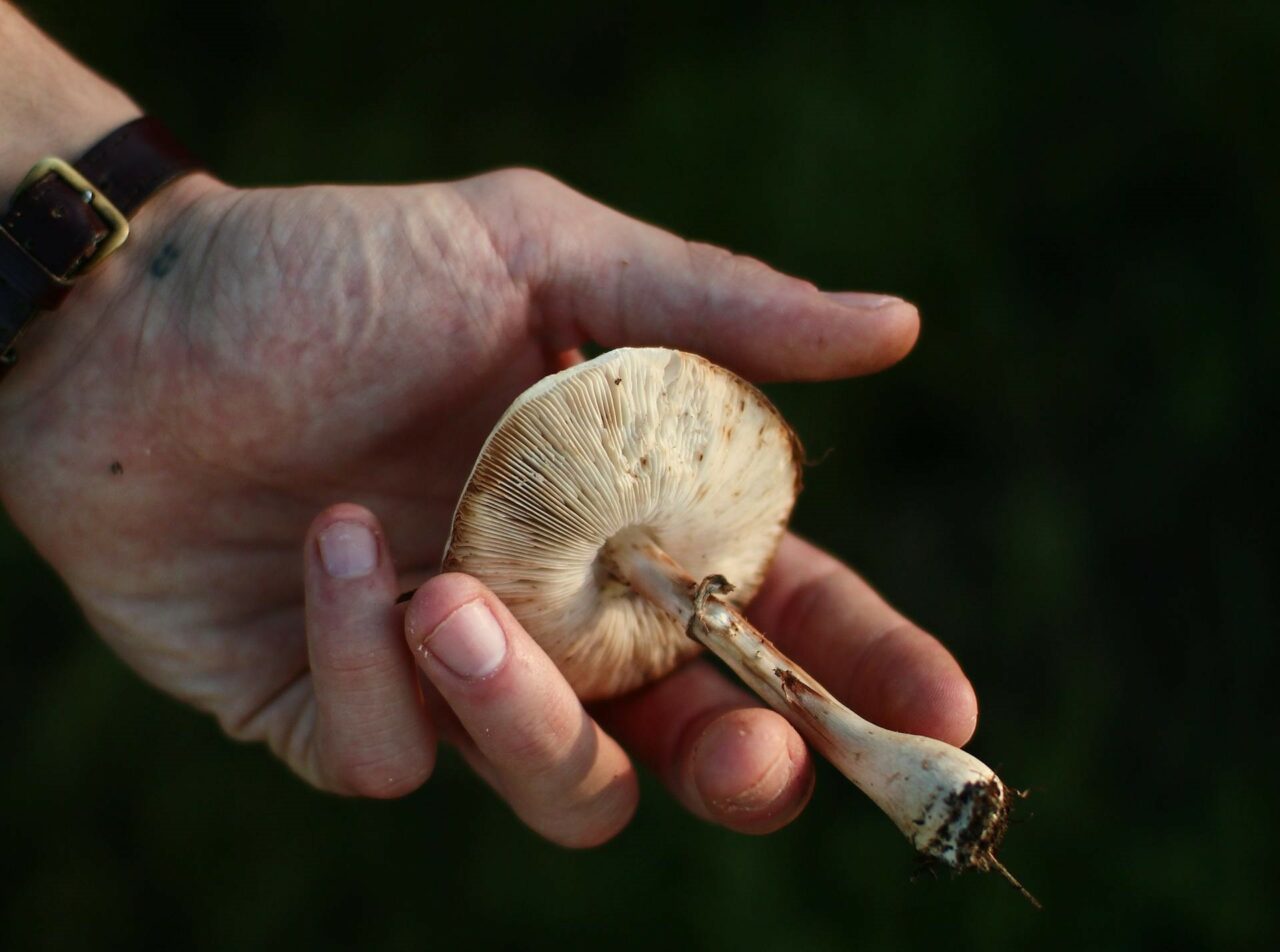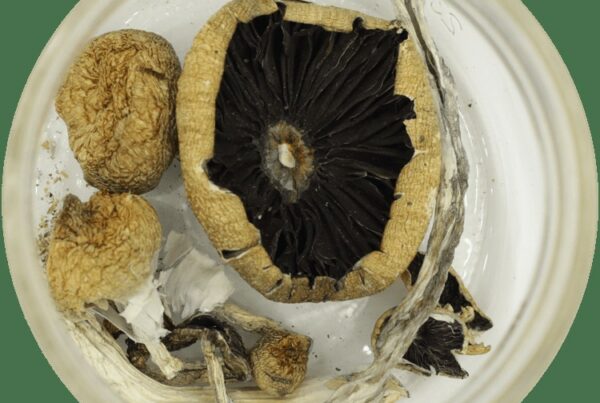Traditionally used as a psychedelic, Psilocybin mushrooms function as a serotonin 5-HT2A receptor agonist, similar to LSD. Currently, these mushrooms are being researched for their potential in psilocybin-assisted therapy to treat mental health conditions such as major depression, anxiety, emotional distress, cluster headaches, and migraines.
Understanding how shrooms alleviate these conditions requires studying their metabolism in the body. This knowledge helps both researchers and users to comprehend how the active compound produces psychological and therapeutic effects. This piece provides an essential overview of the pharmacology and pharmacokinetics of psilocybin.
[toc]
Key Points:
- Once orally ingested, half of the psychedelic fungi is absorbed and disseminated throughout the body.
- The fungi compound primarily undergoes dephosphorylation in the liver through the enzyme alkaline phosphatase.
- About 3.4% of the compound gets excreted in its initial form within 24 hours, while the rest is expelled as a stable metabolite.
What Does Pharmacokinetics Mean?
Pharmacokinetics (PK) refers to the study of how the body handles substances like drugs once they’re introduced into the system. Although it’s related to pharmacodynamics, which explores how a compound interacts with the body, PK specifically focuses on four main aspects: absorption, distribution, metabolism, and excretion (ADME).
Comprehending these processes enables healthcare professionals to prescribe the most effective medications with the least risk. It also allows them to customize treatments according to each patient’s unique physiology and lifestyle.
How Does Pharmacokinetics Relate to Psilocybin?
Psilocybin and psilocin, the primary active compounds found in certain types of magic mushrooms, have attracted significant attention from both researchers and users. Pharmacokinetics studies how the body handles mushrooms containing psilocybin and aids in understanding their potential effects, whether for medicinal or recreational purposes.
These compounds come under various names, including “magic,” “psychedelic,” “medicinal,” or “sacred.” The fungi containing these compounds are ingested, with The types of these mushrooms, their place of origin, size, growth and drying conditions, and age can lead to significant variations in their concentration levels.
Although these mushrooms occur naturally in the environment, scientific advancements have enabled their synthesis in laboratories. Both the naturally occurring and synthetic variants exhibit low toxicity, though some individuals may experience minor side effects such as nausea or vomiting.
Despite these physical side effects, the compounds present in these mushrooms have demonstrated potential therapeutic benefits due to their safety profile and non-addictiveness. This has prompted further research into their application in psychotherapy, particularly for treating anxiety and depression.
The 4 Phases of Pharmacokinetics
The compound present in these mushrooms, psilocybin, is inactive in its initial state and acts as a prodrug, transforming into its active state, psilocin. Enzymes such as alkaline phosphatase facilitate this conversion, enabling psilocin to be absorbed and circulated throughout the body, reaching various tissues. However, after oral ingestion, psilocybin is undetectable in the circulatory system, feces, or urine.
Absorption
Absorption is the process by which the compound enters the bloodstream from its administration site. It plays a key role in determining the speed and effectiveness of the compound reaching its target, such as the plasma. The most common method of administration is oral, though inhalation has been tried, it lacks the effectiveness of oral consumption.
The absorption process also includes the release of the compound from the dosage form during oral ingestion. Factors such as delays in the throat or esophagus can affect this, potentially leading to slower results or irritation. Once the compound reaches the stomach, the acidic environment could start to break it down before it enters the bloodstream.
Research conducted on animals suggests that only around 50% of orally administered psychedelics are absorbed and distributed throughout the body.
Factors Affecting the Absorption Process
Several factors can influence the absorption process, leading to variations in the onset, intensity, and duration of effects:
- Stomach Contents: Eating before consuming the compound can delay the absorption process as it slows down the onset of effects. On the other hand, an empty stomach promotes quicker absorption.
- Body Fat: Compounds have the capability to accumulate in fat tissues, potentially prolonging their impacts.
- Age: Metabolic rates and body composition are subject to changes with age.
- Zero-Order Kinetics: The substance is eliminated at a steady rate, regardless of its concentration.
- First-Order Kinetics: The elimination rate is proportional to the concentration of the drug.
The term distribution corresponds to the spreading of psilocin in the body after its introduction into the bloodstream. Psilocin, possessing lipophilic properties, can traverse the blood-brain barrier and infiltrate the central nervous system.
The product’s size, polarity, and protein-binding capabilities, along with an individual’s physiological characteristics, such as hydration status and body composition, significantly impact this distribution process.
The goal is to achieve a potent concentration at the target site. For effectiveness, the substance needs to reach the assigned location, guided by the volume of distribution, while remaining unattached to proteins, allowing it to interact with its receptor actively.
What Affects the Distribution Process?
Several elements can influence the distribution process:
Typically, the effects become noticeable within 20-40 minutes after ingestion, peaking around 80-100 minutes. The impacts of magic mushrooms generally persist for about 4-6 hours.
How Does the Brain Receive the Distribution?
Initial experimental research on two species demonstrated that the order of binding preference is 5HT2A > 5HT1A > 5HT2B [23]. It also connects to receptors of dopamine D1, 5HT1E, 5HT5A, 5HT7, 5HT6, D3, 5HT2C, and 5HT1B.
It acts as a partial agonist at the 5HT2A receptor, with an efficacy of approximately 40%. The psychedelic effects can be linked to its partial agonist activity at 5HT1A autoreceptors.
The mood-enhancing and psychotomimetic experiences could be attributed to the noted association between increased dopamine levels and sensations of depersonalization and euphoria. Hallucinogens work by modifying neurochemistry and receptor activity. It enhances 5HT2A agonist activity by boosting BDNF synthesis in the hippocampus, thereby encouraging neurogenesis and alleviating fear-related behaviours conditioned by prior experiences.
Elimination
Elimination refers to the procedure by which the
The human body expels a substance mainly via the kidneys, but also through the lungs, skin, or digestive tract. In the kidneys, a naturally occurring psychedelic drug is filtered in the glomerulus or secreted in the tubules. Some reabsorption occurs, adding a layer of intricacy to the process.
The primary compound has a half-life of about 160 minutes, while psilocin’s half-life lasts roughly 50 minutes. Animal studies suggest that this substance is primarily excreted in the urine, accounting for about 65% within 8 hours of consumption, although traces can still be found in smaller amounts in bile and feces.
In human bodies, around 3.4% of the substance is expelled in its original form within 24 hours, while the majority is excreted as psilocin-O-glucuronide, a more stable metabolite. This stability allows the compound to be detected in urine samples for an extended period.
There are two primary substance excretion methods:
Most psychedelic drugs follow the first-order kinetics process, reaching steady-state concentrations after approximately four to five half-lives. Complete elimination also occurs after about four to five half-lives.
Discover Our Range of Psychedelic Mushrooms
The metabolic process varies across different types of fungi. By buying from reliable online providers like Funguyz Canada, you can avoid inadvertently consuming poisonous mushrooms. Certain varieties, such as Agaric mushrooms, can induce strong and undesirable effects. Hence, it’s vital to obtain magic mushrooms from trusted dispensaries, rather than taking risks with street vendors or wild foraging.
| Feature | Enigma | Full Moon Party | Gold Member | |
| Strain Type | Psilocybe Cubensis OMNI | Psilocybe cubensis (Thai Koh Samui) | Psilocybe cubensis | |
| Potency | Exceptionally high; 3.8% tryptamine content | Moderate to high potency | High potency | |
| Visual Characteristics | Resembles a blob or | Resembles a cauliflower or brain-like structure | Classic appearance of cubensis; medium in size | Has thick white stems; golden caramel-colored caps; visible blue bruising |
| Effects | Known as the most potent variety; generates intense effects | Produces a strong mental high; onset is delayed but visuals are pronounced | Induces powerful visual experiences and feelings of euphoria |
Online Information About Psilocybin Mushroom Usage
It’s crucial for medical professionals, researchers, and users to understand the pharmacokinetics of shrooms. This understanding allows you to make educated decisions about dosage and timing, thus reducing potential risks.
Discover your perfect psychedelic experience at Funguyz Canada. Whether you desire a serene journey or a deeper exploration, our extensive range of products is tailored to meet your unique requirements. We offer premium, safe, and quality-assured shrooms, eliminating worries about unreliable sources or poisonous mushrooms.
Explore the best magic mushrooms Canada has to offer, and take your psychedelic journey to new heights.
Frequently Asked Questions
Do shrooms interact with any other medications?
Our products can potentially interact with certain medications, particularly those that affect serotonin levels, like SSRIs (Selective Serotonin Reuptake Inhibitors). SSRIs and SNRIs (Serotonin and Norepinephrine Reuptake Inhibitors) usually reduce the effects, unlike non-serotonergic antidepressants. This reduction in effect can last up to three months after stopping the use of the antidepressant.
Do all psychedelics follow the same metabolic pathway as psilocybin?
No, every psychedelic substance has a unique structure that requires different metabolic processes to become active, and they interact with various receptors in the body. The route of administration also affects how each psychedelic is absorbed. While the basic principles of absorption, metabolism, and distribution stay the same, the specific pathways and effects vary for each substance.
Does the form of the shroom affect its pharmacokinetics?
Yes, the form of the shroom (be it fresh, powdered, or dried) can influence the absorption rate. For example, powdered forms might be absorbed faster than whole dried forms due to quicker dissolution.
Related Reading:





